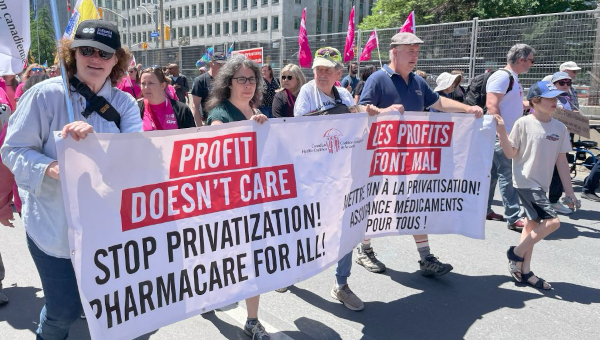Pension Fund Capitalism and the COVID-19 Pandemic: The Case of Revera
Of the many crises provoked by the COVID-19 pandemic across Canada, the dire situation in long-term care facilities and retirement housing may be the most widely and urgently recognized. Even Ontario Premier Doug Ford, whose own party engineered the significant shift to more privatized and ‘marketized’ long-term care (LTC) provision in the 1990s, recently declared the system to be “absolutely broken.”
A scathing report prepared by Canadian military specialists sent by the Ontario government to provide emergency staff support to five (eventually six) of the province’s worst-hit homes described the conditions found as “gruesome.” A subsequent report from the Canadian Institute for Health Research (CIHI) found that Canada has had the highest proportion of total COVID-19 related deaths in LTC facilities (81%) among the 17 OECD countries studied. Public policies promoting the partial commodification, deregulation, and underfunding of seniors’ care in the LTC system by neoliberal governments in Ontario and across the country have now been exposed as nothing short of catastrophic.

While less discussed, the media has also reported on the peculiar role being played within this “broken” system by one of Canada’s largest pension funds. The Public Sector Pension Investment Board (PSP) is a federal crown corporation established in 1999 to invest the pension funds of federal public service workers, along with most of military personnel and RCMP employees. Since its acquisition in 2006, PSP has owned and operated the second-largest for-profit LTC company in the country under the name ‘Revera’. PSP’s ownership of Revera is not in the familiar passive form of a pension fund buying a small packet of equity shares in the company and collecting dividends. Rather, as part of a recent wave of ‘private equity’ corporations getting more directly involved in for-profit healthcare, PSP bought an existing chain of care homes in 2006 and consolidated it under a new management structure that it fully controls. As its 100% owner, PSP is Revera.
Privatization, Deregulation, and Mismanagement
The social implications of this ownership are especially troubling in the context of the COVID-19 pandemic. The terrible consequences of the privatization, deregulation, and mismanagement of so much of our long-term care have provoked serious questions. How could such an important system have become so broken? Who broke it, and for whose benefit? Most importantly, this crisis has generated a wave of demands for the entire LTC sector to be taken into full public ownership. These demands, which polls indicate have wide popular support, put the spotlight on the central involvement of PSP and other workers’ pension funds in this “business.”
Even prior to the pandemic, long-term care was well known for its exploitative labour regime, a system imposed on a workforce that is very disproportionately comprised of women and racialized workers. The direct care work involved has been systematically deregulated and shifted from nurses to lower-paid personal support workers (PSWs) and care aides. Very low wages are often combined with part-time and precarious scheduling systems that force workers to take up multiple jobs at different facilities to get enough hours to survive. Subcontracting key functions, such as food service, laundry, and cleaning, to private for-profit companies is pervasive. (Some non-profit and public homes in Ontario are now privately contracting out the management of entire facilities.) In combination, these business practices have made owning, operating, and managing LTC homes highly profitable for their corporate owners and managers, and also unstable and under-resourced places to work and to live. It is for these reasons that LTC facilities have been left incredibly vulnerable to an outbreak of serious viral infection.
In this context, PSP’s move into this sector is an especially revealing example of what has been referred to as “pension fund capitalism.” This term has been used to signify the shift that has aligned and implicated pension fund investment managers in neoliberal policy shifts – favouring deregulation, privatization, and intensified worker exploitation. The phrase also signals the fact that pension funds themselves have become key actors within sectors where longer-term ‘fixed capital’ investment, such as public infrastructure and real estate, play a central role in this reconfigured kind of capitalism.
This crisis – a combination public health, social, and economic crisis sparked by the COVID-19 pandemic – offers an opportunity for the left, the labour movement, and pro-public healthcare groups to respond to these developments by building a political challenge to capitalist business-as-usual as it relates to healthcare. It seems clear that most workers do not want their retirement incomes to be derived from the worker exploitation and diminished care provision that is so central to the profit making in long-term care. If so, a serious effort to mobilize pension plan members in support of a campaign to decommodify and transform long-term care could play a role in blocking these processes of capitalist restructuring and at the same time meaningfully strengthen Canada’s public healthcare system. Achieving this would literally save lives.
The COVID-19 Crisis in Long-Term Care
A review of some details of how the pandemic initially unfolded in the LTC sector is instructive. Canada’s Chief Public Health Officer Dr. Theresa Tam reported in early May that some 81% of the country’s COVID deaths were “linked to long-term care facilities.” It is also clear that these death rates are far worse among those facilities owned and operated on a for-profit basis – including many owned by large chain operators. The Ontario Health Coalition has published data showing that these death rates are far higher among the for-profit facilities. An investigative report published by the Toronto Star showed that per capita death rates were four times higher in for-profit LTC homes compared to those publicly owned. Of those residents in Ontario LTC homes that have died of COVID-19, more than half were residents at homes owned by just six for-profit companies. (Revera had the second-highest number of resident deaths in that list as of that report, with 230; data published by journalist Nora Loreto put this figure at 261 as of July 21.)
A more recent study of available data on Ontario’s COVID-19 experience in LTC published by the Canadian Medical Association Journal (July 2020) confirmed that “for-profit LTC homes have larger COVID-19 outbreaks and more deaths of residents.” This study also underlined previous research that found that for-profit homes “tend to deliver inferior care,” which they summarize as including “lower levels and quality of staffing, more complaints from residents and family, higher rates of emergency department visits, more acute care hospital admissions, and higher mortality rates.”
This direct relationship between for-profit ownership and death rates should surprise no one. It is fully consistent with the evidence published by a comprehensive, ground-breaking research collaboration led by York University’s Pat Armstrong. Over many years of comparing Canada’s increasingly private and under-funded system to those of several other countries (including Sweden and Norway), this research has repeatedly shown that profit-driven ownership consistently generates negative outcomes for residents and workers:
“Private, for-profit services are necessarily more fragmented, more prone to closure and focused on making a profit. The research demonstrates that homes run on a for-profit basis tend to have lower staffing levels, more verified complaints, and more transfers to hospitals, as well as higher rates for both ulcers and morbidity. Moreover, managerial practices taken from the business sector are designed for just enough labour and for making a profit, rather than for providing good care.”
They point out that this adoption of practices “from the business sector” exerts downward pressure on wages and working conditions – and quality of care – even in the not-for-profit and publicly-owned facilities. Among their recommendations is an end to such practices, including the extensive subcontracting of so-called “ancillary” services now recognized as crucial to both quality of care and infection control. They also confirm that the disproportionately racialized and feminized labour force has been subjected to increasingly exploitative working conditions.
Crucially, such conditions translate directly into degraded care and living conditions for residents, which these researchers suggest opens up important potential for alliances between workers, residents, and family members who share an interest in transforming this system.
New Calls for Public Ownership of Long-Term Care
The suffering of the pandemic’s hardest hit populations has obviously given significant new force to these recommendations. In recent weeks there has been a steady stream of new and ambitious appeals for long-term care to be treated as vital healthcare – and made fully public, following the model of the Canada Health Act. The Canadian Labour Congress, the Canadian Health Coalition, the federal NDP, and a growing number of public healthcare advocates are demanding a full-scale overhaul of the entire LTC sector so that it can be properly integrated into the public healthcare system. The Canadian Union of Public Employees (CUPE) has launched a major new campaign to this effect, calling for a “well-funded, well-staffed, public long-term care system.” More recently, CUPE was joined by two other unions (SEIU and Unifor) to launch a joint campaign to “end profit-making” in the provision of residential care.
Such a transformation would obviously be no small matter. It would require not only new funding commitments from governments, but also a legal mandate to transfer existing facilities from private to public (or, at a minimum, not-for-profit and strictly regulated) ownership. But the calls for such public control are finding widespread public support. An Angus-Reid poll on the issue showed that fully two-thirds (66%) of respondents supported the full-scale “nationalization” of long-term care. An Abacus Data poll recently released by NUPGE indicates an even larger 86% majority of respondents support having long-term care facilities brought under the ‘universal, accessible’ mandate of the Canada Health Act.
With such a strong mandate – galvanized by the especially catastrophic performance of the for-profit care homes throughout the COVID-19 pandemic – a genuine transformation for this sector suddenly seems achievable. The mechanics of implementation are not clear, but some measure of financial compensation for the homes’ existing private owners would likely be attached. Any such compensation should be closely scrutinized and debated, particularly given the millions of dollars in public subsidies and supports that the companies have been channelling to shareholders and owners.
Of course, the for-profit industry and its extremely well funded lobby have already launched their defence. The largest companies involved – including Extendicare, PSP-Revera, and Chartwell – have been issuing statements to the media rejecting outright the suggestion that private, for-profit ownership of so many facilities has anything to do with the crisis. Industry organizations such as the Ontario Long-Term Care Association (OLTCA) have begun to mobilize such self-interested arguments against these popular pressures, taking full advantage of their links to Doug Ford’s cabinet and Ontario’s governing PC party. The battle is now on. So, what does this mean for the pension fund-LTC operator PSP-Revera?
Pension Fund Capital in For-Profit Healthcare
PSP and Revera are already engaged in a fulsome defence of their ownership rights in this sector, so understanding some basics of their history may be useful. The full, legal name of PSP is Public Sector Pension Investment Board (PSPIB), and it was established as a federal crown corporation in 1999 after the Liberal government of the day decided to build up a fund of financial market assets linked to federal government-sponsored pension plans. One of the largest such funds in the country, they now manage some $170-billion in assets, with about $66-billion of that amount held in private equity, infrastructure, or real estate.
Among PSP’s earliest major acquisitions was a friendly $800-million takeover of an existing for-profit LTC and retirement home company (Retirement REIT) whose Board was chaired by former Tory Premier Bill Davis and also included former Ontario Finance Minister (and later premier) Ernie Eves. Once “Revera” was launched, Davis was invited to join the Board of the new company – and he is still there. These close PC-LTC industry relationships were developed even further in 2003 when former Premier Mike Harris joined the Board of Chartwell Retirement Residences shortly after leaving politics. He is still there today. This means three of the last four PC Ontario premiers have spent time on the boards of these companies – with Doug Ford the only exception.
After Revera was launched as a “private” entity, PSP quickly consolidated it into a multinational operation with more than 500 LTC and retirement homes in Canada, the US, and the UK. According to one recent study, it is now the second largest corporate LTC chain in Canada.
PSP’s move into this sector was rooted in the politics of privatization that marked the neoliberal turn of the 1980s and 1990s. Following the recession of 1991, the federal and most provincial governments worked to cut taxes and social transfer payments, reduce the role of public ownership in the economy, and make private ownership of various types of public infrastructure easier and more profitable. This was particularly the case in Ontario, where the hard-right governments of Mike Harris and Ernie Eves (1995-2003) showed an ideological preference for private, for-profit ownership in, among other areas, long-term care. According to Justin Panos’ brief history, regulatory and legislative changes in that period significantly shifted a sector that had previously been primarily public or not-for-profit into a far more attractive field for private capital to occupy.
In Ontario, these policy changes included the elimination of a minimum-hours standard of care per resident, the de-linking of public funding flows from staffing levels, and the provision of 20-year streams of government payments to for-profit corporate operators to build new LTC facilities. When combined with serious shortages of available beds for a rapidly growing senior population, these policies greatly enhanced the sector’s profitability. Real estate and financial firms began buying up and consolidating individual homes (both private and non-profit) into larger, for-profit chains operating both publicly-supported LTC as well as what have come to be called “retirement residence” facilities or “retirement homes.” (In 2015, the Ontario Teachers Pension Plan expanded their interest in the retirement residences sector by combining the Amica chain of facilities with an existing portfolio of homes under the name Baybridge.)
As a result, investors in private LTC companies, such as Chartwell, have been rewarded with consistently high profit rates, ranging from 9.6% to 12.6% from 2007 to 2012 according to one study. While Revera’s profit rates are not disclosed – even to federal public service plan members – its tax-exempt status, bestowed as a result of its pension fund ownership, suggests that its annual profits may be even higher than this. But these profit levels are not disclosed, and most financial information is even redacted out of reporting required by requests using federal Access to Information legislation.
The Contradictions of ‘Pension Fund Capitalism’
The historic shift of pension fund practices, from primarily passive investment in stocks and bonds into active, direct operation of corporations such as Revera, raises challenging questions about the relationship between pension plan members and these controversial new portfolios. It has been suggested that this could have a perverse impact on the political views of plan members and their unions with respect to sensitive policy topics such as the private ownership of healthcare facilities. A columnist with the Toronto Sun recently suggested that trade union advocates of full public control over LTC facilities don’t appear to “have much to say” about care homes that are owned by “workers’ pension funds” – citing PSP’s ownership of Revera (along with the ownership of the Amica-Baybridge chain of residences noted above). When the workers who belong to such pension plans learn that “their” funds own and profit from these companies, the columnist argued, their perspective on the legitimacy of such private ownership will become more positive simply out of financial self-interest.
However, there are several reasons that this columnist’s confidence about this is misplaced. First, it is quite clear that until recently, very few members of the federal government pension plans that use PSP were even aware that “their” pension fund owns and operates Revera. Pension plan members are told very little about the portfolios or investment practices of their funds, with managers generally limiting such communication to their latest annual ‘rate of return’ and some very abstract commentary about their investment ‘principles’. If the 850,000 members of PSP’s client pension plans were told about its Revera operation, and the real, brutal basis of its profitability, it seems likely that a very large number would want nothing to do with it – if they had any choice in the matter.
Secondly, the membership of the pension plans that have their funds invested by PSP is composed primarily of public sector workers, most of whom are, or were, members of unions with strong commitments to public services and public ownership. It also includes over 400,000 retirees and survivors receiving benefits – at least some of whom are themselves likely to be residents of a troubled LTC facility operated by Revera or one of the other for-profit facilities. These members of the client plans of PSPIB may well be even more likely to support moving to a fully public long-term care system than the general public recently polled.
Third and most significantly, the recent exposure of Revera’s ownership by PSP has prompted the largest union representing federal public service workers – the Public Service Alliance of Canada (PSAC) – to follow up on previously-expressed concerns with a public call in May for the full-scale transfer of Revera to public ownership. PSAC president Chris Aylward argues that his union has long believed that these facilities should be publicly owned and managed. He argues that the growing number of recent class action lawsuits against Revera and the grave problems exposed by the COVID-19 crisis illustrate that the PSP’s ownership of this company now poses a clear “material risk” to plan members.
PSAC appears to be quite right about this risk. According to a Toronto Star investigation, some $1.5-billion in dividend-profits have been flowing into the pockets of private LTC company shareholders over the last decade – a figure that does not even include the unreported profits captured by Revera. Now, the disaster of the COVID-19 pandemic has provoked a number of multi-million dollar class action lawsuits citing negligence causing death against Revera, Sienna, and other private operators. This litigation, combined with concerns relating to both pandemic and pre-pandemic problems, has triggered a collapse in the share values of the large for-profit LTC companies. Will these companies continue to reap significant profits in the coming years?
The PSAC, other unions, and plan members, have a very good reason to oppose “their” fund being invested in this risky and socially harmful profiteering. The pro-public control statements, campaign launches, and other responses to this crisis from the labour movement suggest that the private corporate operators in this sector have already lost a great deal of their legitimacy. This includes PSP-Revera.
Revera and the For-Profit LTC Lobby
Whether these companies can survive financially may well be decided in the battle over public policy now being waged. Will governments bail out these troubled companies, which have for years extracted large profits by underinvesting and understaffing their facilities, while underpaying workers? In the past, it has been public policy decisions that determined the portion of public funding taken in by these private providers, and it has been government policy that protected the companies from the “costs” of minimal staffing standards – despite pressure from both resident advocates and unions.
But the pandemic has provoked an intensified policy “engagement” from the for-profit LTC sector in Ontario, which is likely to have parallels across the country. It was recently reported that five of the for-profit LTC corporations (including Revera) have enlisted the services of professional lobbyists who previously worked inside the Ford cabinet to lobby their former employers on their behalf. Their agenda in doing so is no secret – they will be looking to counter the popular momentum behind moving to public ownership and management of the LTC sector.
These lobbyists will press for urgent increases in the public funding that flows to them, such that their ongoing profitability will be secured. In fact, they have already scored an important victory with the Ford government’s rapid passage of quasi-bailout legislation (Bill 161) that will provide at least some measure of “immunity” to the for-profit providers, and itself, even from entirely valid COVID-19 death-related class action lawsuits. This measure was then supplemented by an announcement of a massive infusion of public funding for new and redeveloped LTC beds, much of which will flow to the for-profit entities.
Of course, such lobbying may not even be necessary, as established neoliberal reflexes are reinforced by the close links between the for-profit LTC industry and Ontario’s PC party (noted above). In addition to his appointment to the Board of LTC operator Chartwell, former Premier Mike Harris has also spent time as a ‘Fellow’ of the hard-right Fraser Institute, arguing alongside former Reform Party leader Preston Manning for the further privatization of Canada’s public healthcare system. As noted above, former Tory premier Bill Davis has had a seat on the PSP-Revera Board from its inception. His presence surely continues to serve a useful purpose, even symbolically. While both former Tory premiers have presumably received generous compensation for their services over the years, their most important role may be as communications conduits for company agendas.
Notwithstanding such existing linkages, these corporate-political relationships are further organized and brokered through the province’s industry lobby group mentioned above, the Ontario Long-Term Care Association (OLTCA). Alongside all of the other major for-profit firms, Revera is represented on the OLTCA Board of Directors by its Senior VP for Long Term Care, Wendy Gilmour, whose personal background is in private sector lab service companies CML and Lifelabs. The primary spokesperson for OLTCA, Donna Duncan, is yet another LTC industry player with past connections to Ontario Tory politicians, having served as policy director for then-PC leader John Tory in 2006 as well as “various” roles in the Government of Ontario in the 1996-2001 period (most of the Mike Harris years).
But Revera also intervenes politically on its own accord. From the time of its formation, the company – again, a subsidiary of a federal crown corporation – has made thousands of dollars in direct donations to those provincial political parties it sees as representing its interests. (Notably, according to the National Post’s donations database, the company has not reported any donations to the NDP.) In this context, we can anticipate that Revera, alongside its fellow for-profit LTC operators in Ontario and across Canada, will be working hard in the coming weeks to defend for-profit long-term care, and to politically oppose the growing popular calls to make the entire sector public.
Challenging Revera and ‘Pension Fund Capitalism’
Most workers do not want their pension benefits, or their RRSP or mutual fund investments, to be built from the exploitation of other workers, or the privatization and degradation of public services such as healthcare (including long-term care). For this reason, it should not be surprising that the pension and retirement fund industry appears to limit disclosure of their most politically sensitive investments. The PSAC’s call for relinquishing PSP’s ownership of this company, and its transfer into public hands, is an exceptionally bold demand. Similar calls from other unions representing federal public service workers, and from members of the general public, may well follow.
But while the Revera case may be a particularly disturbing example of predatory pension fund investment, it is not exceptional. The PSP also holds significant private equity stakes in corporate entities that own and operate other kinds of public infrastructure, including airports, electricity generation and transmission, toll highways, child care centres, and even a US company specializing in for-profit physician outsourcing. These are among the most socially and politically sensitive types of “public infrastructure,” and include investments into functions that many people in Canada (and many pension plan members) feel should be publicly owned and managed in the public interest.
These kinds of investment holdings and practices reflect an industry-wide 20-year trend among Canada’s large pension funds, including CPPIB, Ontario Teachers, Caisse de dépôt et placement du Québec (CDPQ), and OMERS. Such pension fund strategies reflect the ongoing ‘financialization’ of vital public services and infrastructure. Virtually all of the largest Canada-based pension funds have channeled billions of dollars into these very same sectors, often in other countries where their controversial social impacts are less likely to be reported. As with the case of Revera and long-term care, these large pension funds have not only taken advantage of the opportunities that neoliberal policies have created, they have also collaborated and formed partnerships with other giants of global finance to maintain and extend them ever further.
These powerful collaborations and agendas must be politically challenged. When institutions of private capital like PSP-Revera run into inevitable clarifying moments – such as the COVID-19 pandemic – social movements of workers and public interest advocates need to seize them to build the counterweight we need. In this case, two key strategic initiatives present themselves. First, the tragic case of Revera, and the loud new calls for long-term care to be made fully public, offer an opening for those of us arguing that this system can only be fully fixed through a combination of accountable public ownership and enough public funding to allow the care work at its centre to be fully decommodified, valued, and properly compensated. Along with trade union and social advocacy campaigns in this direction, pension plan members and their unions can insist that any pension investments involving privatization or private for-profit management of public services and infrastructure be, at bare minimum, fully disclosed. As a principle, we should know what is being done in our name, with what we are told is “our” money. From there, we can entertain the serious debates needed about how we can work to ensure that the role currently played by pension funds and other forms of private capital in the provision of healthcare, social care, and other vital public services is phased out entirely.
Secondly, and over the longer term, the labour movement and the retirement security movement need to develop a strategy for reversing the expanded “financialization” of our pension system. That process has involved more than just workplace pension plans and fund managers like PSP. Through a series of public policy measures, the Canada Pension Plan (CPP) and the Québec Pension Plan (QPP) were re-engineered into massive financial asset funds that now hold over $750-billion in global financial markets. As these funds were being built up, retirement security was being re-framed as an individual under-investment problem, to be solved through more private savings into individualized RRSPs and investment savings accounts – highly profitable products that channel these savings into financial markets with ecologically destructive and anti-social appetites. In that light, the Revera case and the COVID-19 pandemic have underlined the serious risks of building our vital social systems on a foundation of private financial profits. The alternative we now urgently need is a universal and adequate public pension system that is secured – like public healthcare – by our collective commitment to each other. •
Kevin Skerrett will be speaking on a panel on behalf of the Ottawa Health Coalition at an open, virtual Town Hall called “Make Revera Public” on Wednesday, September 16th, 7:00pm to 8:30pm. To register to join this Town Hall, follow this link, Facebook event. A confirmation of the Zoom meeting and Zoom meeting link will be sent to your email.
Thanks to Natalie Mehra of the Ontario Health Coalition and Steve Maher for very helpful comments and input on a previous draft of this article.






